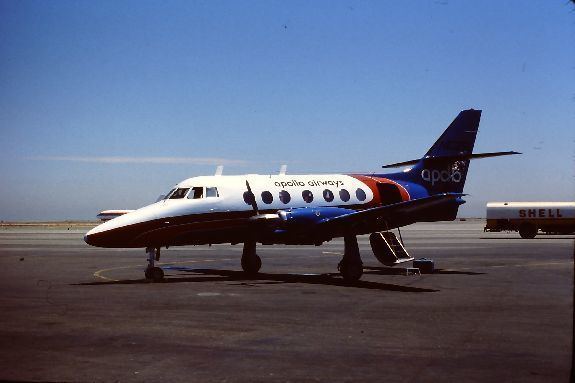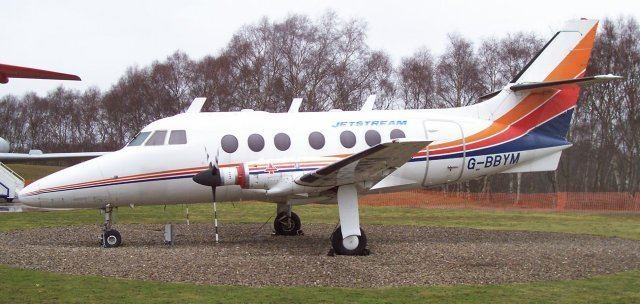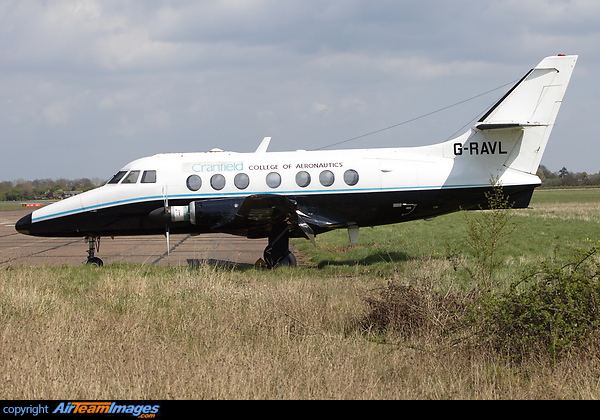Wingspan 16 m Introduced 1969 | Length 14 m | |
Manufacturers | ||
The Handley Page HP.137 Jetstream is a small twin-turboprop airliner, with a pressurised fuselage. The aircraft was designed to meet the requirements of the United States commuter- and regional airline market. The design was later improved and built by British Aerospace as the BAe Jetstream 31 and BAe Jetstream 32 featuring different turboprop engines.
Contents
- Development
- Variants
- Operators
- Civil operators
- Military operators
- Former Military operators
- Accidents and incidents
- Specifications Series 200
- References

Development

Handley Page was in an awkward position in the 1960s, wishing to remain independent of the "big two" British companies (Hawker Siddeley and the British Aircraft Corporation), but without the money needed to develop a large new airliner that would keep it in the market. After studying the problem it decided that its next product would be a highly competitive small airliner instead, filling a niche it identified for a 12–18 seat high-speed design. American salesman and modification engineer Jack Riley claimed to have written the design specifications. The design garnered intense interest in the US when it was first introduced, and an order for 20 had been placed even before the drawings were complete. Charles Joy was responsible for the design.

The original design dates from 1965 as a 12-seat (six rows with a centre aisle) aircraft. The aircraft was a low-wing, high-tail monoplane of conventional layout. Considerable attention was paid to streamlining in order to improve performance, which led to one of the design's more distinctive features, a long nose profile. The fuselage had a circular cross-section to ease pressurisation, allowing much-higher-altitude flights and consequent higher speed and comfort than competing unpressurised designs. One drawback of the design was that fuselage was so small in cross-section that the cabin floor had to be "lowered" to allow stand-up passenger entry and egress through the rear door. This meant that the main spar had to run through the cabin, causing a tripping hazard.

Final assembly took place in a new factory at the Radlett aerodrome, but large portions of the structure were subcontracted, including complete wings being built by Scottish Aviation at Prestwick, Scotland and the tail section by Northwest Industries of Edmonton, Alberta, Canada. The original design used Turbomeca Astazou XIV engines of approximately 840 hp (626 kW), and flew on 18 August 1967 as the Jetstream 1. Throughout the test program the engines proved to be a weak point, being generally underpowered for the design, and surprisingly temperamental for what was then a mature and widely used turboshaft design. Testing was eventually moved to the Turboméca factory airfield in the south of France, both to allow faster turnaround with engine work, and in order to improve the schedule by taking advantage of the better weather.

In order to improve sales prospects in the US, the fifth prototype was fitted with the US-built Garrett TPE-331 in place of the French Astazou. Changing to the US-built engine was enough to allow the United States Air Force (USAF) to consider it for cargo use. It eventually placed an order for 11, fitted with a cargo door and accommodation for 12 passengers or six stretcher cases, to be known as the C-10A, or Jetstream 3M. The USAF cancelled its order in October 1969 citing late delivery.

The first production model Jetstream 1 flew on 6 December 1968, and over the next year 36 would be delivered. However, by this point Handley Page had given up on the original engine, and the Jetstream 2 was launched with the larger 965 hp (720 kW) Astazou XVI, starting deliveries in late 1969. The late delivery and engine problems had driven development costs to over £13 million, far more than the original £3 million projections. Only three Jetstream 2s would be completed before Handley Page went bankrupt, and the production line was eventually shut down in 1970.
There was enough interest in the design that it was first picked up by a collaboration of investors and Scottish Aviation which formed a company called "Jetstream Aircraft" to produce the aircraft. A further ten Jetstream 1s were produced by this team. Scottish Aviation continued production of the Jetstream 2 as well, although referring to it as the Jetstream 200. In February 1972, 26 Jetstream 201s were ordered by the Royal Air Force, which used them as multi-engine trainers as the Jetstream T.1. Fourteen of these were modified as observer trainers for the Royal Navy, receiving the designation Jetstream T2.
Variants
Operators
The aircraft was used mainly by corporate operators and scheduled passenger commuter/regional airlines.
Civil operators
Military operators
Former Military operators
Accidents and incidents
Specifications (Series 200)
Data from Jane's All The World's Aircraft 1976–77.
General characteristics
Performance
